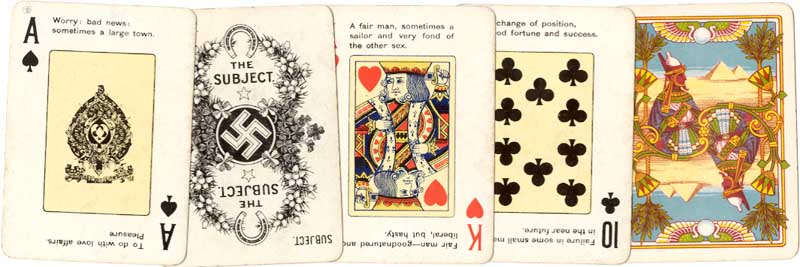Rameses Fortune Telling
The Rameses Fortune Telling Cards were manufactured by Chas. Goodall & Son Ltd, London, c.1910, around the same time as Rameses The Egyptian Wonderworker, was performing.
Rameses Fortune Telling Cards, c.1910
Rameses Fortune Telling Cards were manufactured by Chas. Goodall & Son Ltd, Camden Works, London, c.1910, around the same time as Rameses The Egyptian Wonderworker, the successful magician illusionist (see image below), flourished. The cards have fortune-telling interpretations printed at the top and bottom of each card, and are presented in a mock snakeskin box which includes an instruction leaflet explaining how to shuffle and lay out the cards for readings, plus a rough outline of the meaning of each card. The back depicts a double-ended Egyptian scene.
Many fortune-telling packs share a repertoire of symbolic items such as clouds, a key, the sun, a coffin, and so on. Standard playing cards have been widely used for fortune-telling and over time the single cards in the pack have acquired certain fortune-telling meanings. In a number of cases these meanings are printed at the edges of the card, as in this example.

Above: The Rameses Fortune Telling Cards, manufactured by Chas. Goodall & Son Ltd, Camden Works, London, c.1910. 52 cards + extra 'Subject' card in box. The pack continued well into the 1920's after the tie-up with De La Rue.
Below: Rameses post-card, c.1910. It is not known whether the success and popularity of Rameses the Sensational Wonderworker had any influence on Goodall's pack of fortune-telling cards with the same name, but it is a curious coincidence. Rameses did in fact appear in Camden (possibly at the Bedford Theatre) in 1910. Image and information about Rameses the 'Sensational Wonder Worker' kindly supplied by Chris Woodward.

See also: Argentinean Tarocco • Book of Fate • Cartas Blancas • Cartas Gitanas • Cartomancy & Divination Cards • Edyta Gdek Tarot • 17th Century Fortune-Telling Cards • 72 Names Cards • Geistliche Karten, 1718 • German Fortune Telling cards, c.1818 • Jason Ennis Tarot • Minchiate • Mlle Lenormand Cartomancy • Naipes Tu Destino • Picture Book of Ana Cortez • Picture Show Zodiac Fortune Telling Cards • Ramses II Tarot • Self-Nurturing Solitaire • Tarocco Bolognese • Tarocco Piemontesi • Tarot Egipcios Kier • Welsh Tarot • Tarot

By Simon Wintle
Member since February 01, 1996
I am the founder of The World of Playing Cards (est. 1996), a website dedicated to the history, artistry and cultural significance of playing cards and tarot. Over the years I have researched various areas of the subject, acquired and traded collections and contributed as a committee member of the IPCS and graphics editor of The Playing-Card journal. Having lived in Chile, England, Wales, and now Spain, these experiences have shaped my work and passion for playing cards. Amongst my achievements is producing a limited-edition replica of a 17th-century English pack using woodblocks and stencils—a labour of love. Today, the World of Playing Cards is a global collaborative project, with my son Adam serving as the technical driving force behind its development. His innovative efforts have helped shape the site into the thriving hub it is today. You are warmly invited to become a contributor and share your enthusiasm.
Related Articles

OXO Faces of the Millennium Dinner
Twentieth-century personalities promoting a millennium dinner at the Oxo Tower in London.

Kids Fun Box playing cards
Colourful cards for children with four non-standard suits connected with the natural world.

Tangle Foot Ale
Badger Brewery Tangle Foot strong ale advertising pack.

Scientific Whist
“Scientific Whist” : standard cards with instructions for play on the faces by Chas Goodall & Son, 1...

Agent Provocateur
Branded lingerie collection in a pack of pin-up playing cards.

Nimbus playing cards
Mike Steer’s weather-themed pack with suits in four colours and backs for cardistry.

Agatha Christie and Playing Cards revisited
Agatha Christie uses card-play as a primary focus of a story, and as a way of creating plots and mot...

The Decadent Deck
Studies in the eroticism of the female body by Inge Clayton.

Historic Shakespeare
“Historic Shakespeare” playing cards featuring Shakespearean characters by Chas Goodall & Son.

Copechat Paramount Sorting System
Preserving the past: a specimen deck showcasing edge-notched cards and their ingenious sorting syste...

Heartsette by Herbert Fitch & Co, 1893
A glimpse into a busy print and design office in late Victorian London.

Batman® playing cards
Batman playing cards published by InterCol of London 1989.

Can You Believe Your Eyes?
“Can You Believe Your Eyes?” playing cards featuring visual illusions & other oddities.

Pastime Playing Cards for the Blind
The “Pastime” Playing Cards for the Blind manufactured by Goodall & Son Limd., c.1910.

Songs with Flute accompaniment
Eighteenth century English engraved cards with music for voice and flute.

Love Tests
Vintage novelty “Love Test” cards of a slightly saucy nature but all in good fun!
Most Popular
Our top articles from the past 28 days

